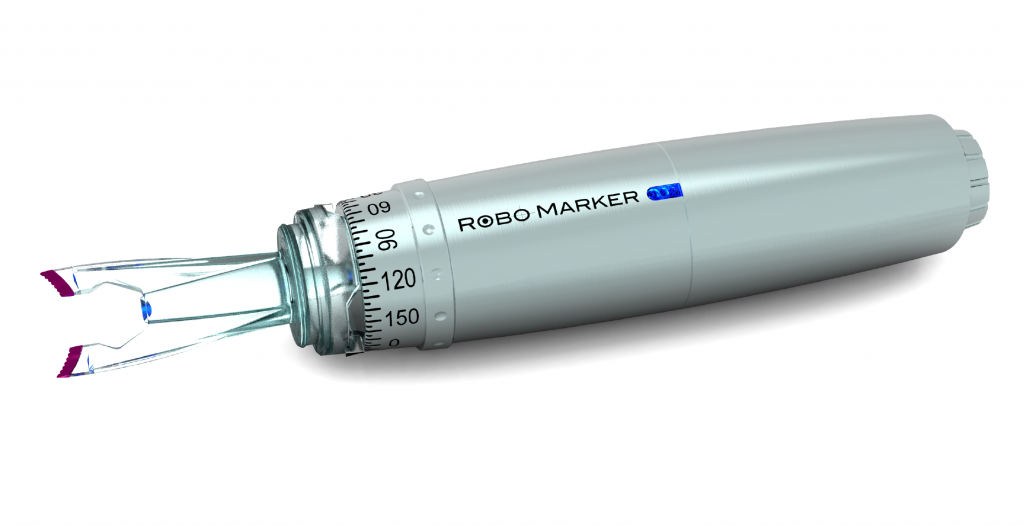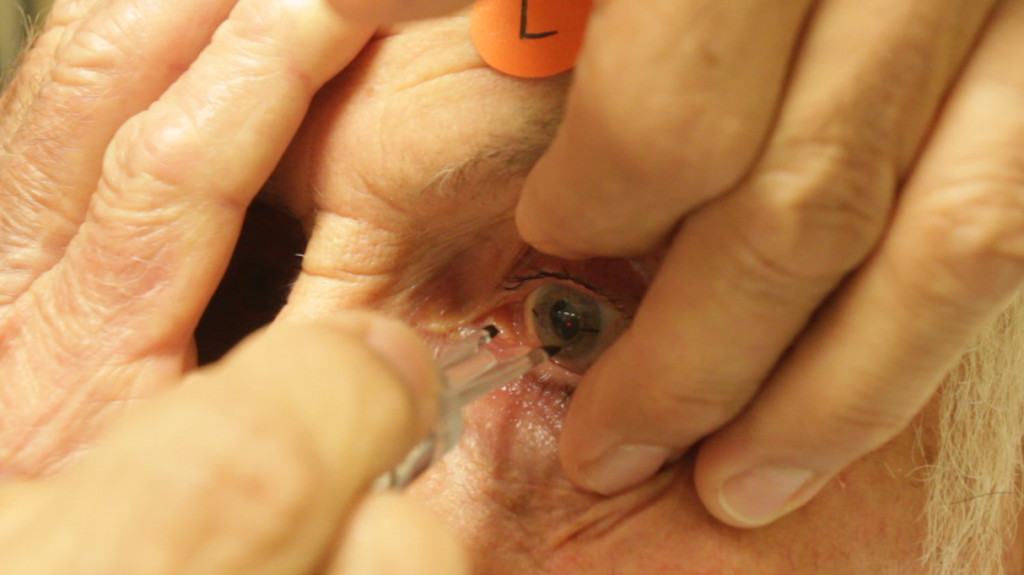Improving alignment
New pendular marker improves toric intraocular lens placement accuracy

Dermot McGrath
Published: Sunday, September 1, 2019
 On the end of the Robomarker, there is a light in the centre that serves as a fixing point for the patient during the tracking. It is clear that the ends are thin, which makes it possible to make clear marks on the limbus[/caption]
An innovative pendulum marker offers eye surgeons a fast and accurate means of accurately aligning toric intraocular lenses (IOLs), offering some clear advantages over traditional ink marking methods, according to Guillaume Boutillier MD, speaking at the French Implant and Refractive Surgery Association (SAFIR) annual meeting in Paris.
“We all know the importance of accurate toric IOL alignment in correcting astigmatism and limiting postoperative refractive errors. This new system works well, is easy to use and resulted in a statistically significant difference in the accuracy of corneal marking,” he said.
Dr Boutillier said that the study, which he co-auhored with Marc Muraine MD, PhD, and Joel Mehech, resident of ophthalmology, was inspired by the fact that his clinic at Rouen University Hospital does not have access to recent guidance tools such as Callisto Eye (Carl Zeiss Meditec) or Verion Image Guided system (Alcon Laboratories Inc.).
“We were using the bubble marker approach in combination with a Mendez ring, a system which leaves a lot to be desired in terms of the precision of marking the cornea. We thought it would be interesting to see how this new marker might potentially improve marking of the axis for correct positioning of the toric lens in order to limit postoperative refractive error,” he said.
Developed in the United States by Surgilum and retailed by Cristalens in France, the RoboMarker uses a gravity-based pendular weight system to ensure that the ring dial maintains the chosen axis. The system uses pre-inked, sterile, disposable tips allowing a one-step marking process with the patient in a sitting position. When applied to the cornea, the marker produces marks that last up to two hours.
Dr Boutillier’s study included 100 eyes of 50 patients scheduled for toric IOL implantation. The right eye of each patient was marked using the RoboMarker and the left with a standard bubble marker and Mendez Ring combination. Following the marking, a photo was taken immediately afterwards, with special software then used to measure the axis alignment and to compare it to the targeted axis of alignment.
The resulted showed a mean error of axis alignment of 3.2 degrees (±2.7 degrees) for the RoboMarker eyes and 6.2 degrees (± 2.9 degrees) for the bubble marker eyes.
[caption id="attachment_16099" align="alignleft" width="1024"]
On the end of the Robomarker, there is a light in the centre that serves as a fixing point for the patient during the tracking. It is clear that the ends are thin, which makes it possible to make clear marks on the limbus[/caption]
An innovative pendulum marker offers eye surgeons a fast and accurate means of accurately aligning toric intraocular lenses (IOLs), offering some clear advantages over traditional ink marking methods, according to Guillaume Boutillier MD, speaking at the French Implant and Refractive Surgery Association (SAFIR) annual meeting in Paris.
“We all know the importance of accurate toric IOL alignment in correcting astigmatism and limiting postoperative refractive errors. This new system works well, is easy to use and resulted in a statistically significant difference in the accuracy of corneal marking,” he said.
Dr Boutillier said that the study, which he co-auhored with Marc Muraine MD, PhD, and Joel Mehech, resident of ophthalmology, was inspired by the fact that his clinic at Rouen University Hospital does not have access to recent guidance tools such as Callisto Eye (Carl Zeiss Meditec) or Verion Image Guided system (Alcon Laboratories Inc.).
“We were using the bubble marker approach in combination with a Mendez ring, a system which leaves a lot to be desired in terms of the precision of marking the cornea. We thought it would be interesting to see how this new marker might potentially improve marking of the axis for correct positioning of the toric lens in order to limit postoperative refractive error,” he said.
Developed in the United States by Surgilum and retailed by Cristalens in France, the RoboMarker uses a gravity-based pendular weight system to ensure that the ring dial maintains the chosen axis. The system uses pre-inked, sterile, disposable tips allowing a one-step marking process with the patient in a sitting position. When applied to the cornea, the marker produces marks that last up to two hours.
Dr Boutillier’s study included 100 eyes of 50 patients scheduled for toric IOL implantation. The right eye of each patient was marked using the RoboMarker and the left with a standard bubble marker and Mendez Ring combination. Following the marking, a photo was taken immediately afterwards, with special software then used to measure the axis alignment and to compare it to the targeted axis of alignment.
The resulted showed a mean error of axis alignment of 3.2 degrees (±2.7 degrees) for the RoboMarker eyes and 6.2 degrees (± 2.9 degrees) for the bubble marker eyes.
[caption id="attachment_16099" align="alignleft" width="1024"] The patient follows the light to the centre as the surgeon approaches the eye. The pendulum head must then be locked at the last moment with the index finger to avoid any rotation at the time of registration[/caption]
“This was statistically significant and while a 3-degree difference may not seem a lot it actually makes a big difference for toric IOL placement. In terms of astigmatism, it equates to about 10% of uncorrected astigmatism for the RoboMarker eyes and 20% for the bubble marker eyes. The other advantage is that the axis marking was finer, ie more precise and therefore easier to identify during the intervention,” he said.
Dr Boutillier said that the study was limited by the fact that it only focused on one potential source of toric IOL alignment and did not take account of alignment errors induced by intraoperative positioning of the lens and postoperative rotation.
“Nevertheless, our clinical experience was that the RoboMarker seems to be precise, rapid and efficient. However, at a cost of around €2,000 it represents a considerable investment,” he concluded.
Guillaume Boutillier: guillaume.boutillier@chu-rouen.fr
The patient follows the light to the centre as the surgeon approaches the eye. The pendulum head must then be locked at the last moment with the index finger to avoid any rotation at the time of registration[/caption]
“This was statistically significant and while a 3-degree difference may not seem a lot it actually makes a big difference for toric IOL placement. In terms of astigmatism, it equates to about 10% of uncorrected astigmatism for the RoboMarker eyes and 20% for the bubble marker eyes. The other advantage is that the axis marking was finer, ie more precise and therefore easier to identify during the intervention,” he said.
Dr Boutillier said that the study was limited by the fact that it only focused on one potential source of toric IOL alignment and did not take account of alignment errors induced by intraoperative positioning of the lens and postoperative rotation.
“Nevertheless, our clinical experience was that the RoboMarker seems to be precise, rapid and efficient. However, at a cost of around €2,000 it represents a considerable investment,” he concluded.
Guillaume Boutillier: guillaume.boutillier@chu-rouen.fr
Tags: iol power calculation, IOLs
Latest Articles
Making Female Leadership More than a Moment
A remarkable global confluence of women in key positions.
ESCRS Talks Technology at AAO
Europe adopts technological advances, US still waiting for lenses and lasers.
Sorting Out Simultaneous Vision IOLs
The ESCRS Eye Journal Club discuss a new landmark paper on IOL classification and the need for harmonisation of terminology for presbyopic IOLs.
Big Advantages to Small-Aperture IOLs
Small-aperture IOLs offer superior image quality with increased range of focus.
Prioritising Self-Care
Benefits of maintaining physical, emotional, and mental health extend beyond the personal sphere.
Valuing Clinical Trial Design
How inclusivity and diversity can enhance scientific accuracy in research.
Knowing Iris Repair: Using Iridodiathermy in Iris Surgery
Prepare for decentred pupils and uneven irides in multiple situations.
Neuroprotectant Treatment for MacTel Type 2
Intravitreal implant releasing ciliary neurotrophic factor found safe and effective in pivotal trials.